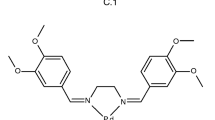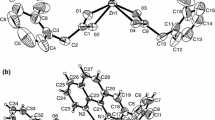Abstract
The structure of new cis-dichloro[(E)-ethyl-2-(2-((8-hydroxyquinolin-2-il)methylene)hidrazinyl)acetate-κ2 N]-palladium(II) complex was determined using a combination of XRD and IR measurements and DFT calculations. Inherent flexibility of its structure is evident from the complexity of its IR spectrum, which could only be theoretically reproduced as a combination of several closely related structures, involving rotation around C–O bond and changes in hydrogen interactions of its –OH group. Its thermal stability and decomposition were studied non-isothermally, and the thermal decomposition mechanism was proposed using correlation with DFT calculations at the molecular level. It was determined that the initial degradation step consists of the release of Cl free radical, which then reacts with both the initial compound and the degradation products. Besides the endothermic steps, there are exothermic ones, contributing to the complex shape of the DSC curve, consisted of overlapping endothermic and exothermic peaks. Deconvolution of DTG curve allowed identification of primary fragments of the initial degradation process and, in conjunction with DFT calculations, construction of the most likely reaction mechanism.









Similar content being viewed by others
References
Legzdins P, Rettig SJ, Sanchez L. Synthesis, characterization, and some chemical properties of unusual 16-electron dialkyl(η5-cyclopentadienyl)nitrosylmolybdenum and -tungsten Complexes. Organometallics. 1988;7:2394–403.
McDonagh AM, Humphrey MG, Samoc M, Luther-Davies B. Organometallic complexes for nonlinear optics. 17. synthesis, third-order optical nonlinearities, and two-photon absorption cross section of an alkynylruthenium dendrimer. Organometallics. 1999;18:5195–7.
Filipović NR, Bjelogrlić S, Todorović TR, Blagojević VA, Muller CD, Marinković A, Vujćić M, Janović B, Malešević AS, Begović N, Senćanski M, Minić DM. Ni(II) complex with bishydrazone ligand: synthesis, characterization, DNA binding studies and proapoptotic and pro-differentiation induction in human cancerous cell lines. RSC Adv. 2016;6:108726–40.
Meneghetti MR, Meneghetti SMP. Sn(IV)-based organometallics as catalysts for the production of fatty acid alkyl esters. Catal Sci Technol. 2015;5:765–71.
Abd El-Wahab H, Abd El-Fattah M, Ahmed AH, Elhenawy AA, Alian NA. Synthesis and characterization of some arylhydrazone ligand and its metal complexes and their potential application as flame retardant and antimicrobial additives in polyurethane for surface coating. J Organomet Chem. 2015;791:99–106.
Chen Z, Wu Y, He C, Wang B, Gu D, Gan F. Insights into the physical basis of metal(II) hydrazone complexes with isoxazole and barbituric acid moieties for recordable blu-ray media. Synth Met. 2010;160:2581–6.
Shankarwar SG, Nagolkar BB, Shelke VA, Chondhekar TK. Synthesis, spectral, thermal and antimicrobial studies of transition metal complexes of 14-membered tetraaza[N4] macrocyclic ligand. Spectrochim Acta A. 2015;145:188–93.
Selvakumar R, Geib SJ, Premkumar T, Govindarajan S. Synthesis, spectroscopic, thermal and XRD studies of aminoguanidinium copper and cadmium oxalates. J Therm Anal Calorim. 2016;124:375–85.
Harmatová Z, Jóna E, Medvecká J, Valigura D, Mojumdar SC. Thermal properties of solid complexes with biologically important heterocyclic ligands. J Therm Anal Calorim. 2015;119:915–9.
Selvakumar R, Geib SJ, Premkumar T, Govindarajan S. Synthesis, structure and thermal properties of a new 1D magnesium sulfoacetate coordination polymer. J Therm Anal Calorim. 2015;121:943–9.
Jin CW, Shen PP, Ren N, Geng LN, Zhang JJ. Structure, luminescent and thermal properties of two novel lanthanide complexes with 3,4-diethoxybenzoic acid and 5,5′-dimethy-2,2′-bipyridine. J Therm Anal Calorim. 2016;126:1549–58.
Begović NN, Blagojević VA, Ostojić SB, Radulović AM, Poleti D, Minić DM. Thermally activated 3D to 2D structural transformation of [Ni2(en)2(H2O)6(pyr)]·4H2O flexible coordination polymer. Mater Chem Phys. 2015;149–150:105–12.
Ristović MŠ, Pavlović MG, Zlatar M, Blagojević V, Anđelković K, Poleti D, Minić DM. Kinetics, mechanism, and DFT calculations of thermal degradation of a Zn(II) complex with N-benzyloxycarbonylglycinato ligands. Monatsh Chem. 2012;143:1133–9.
Hao Y, Peng J, Hu S, Li J, Zhai M. Thermal decomposition of allyl-imidazolium-based ionic liquid studied by TGA–MS analysis and DFT calculations. Thermochim Acta. 2010;501:78–83.
Thomson LM, Hall MB. Theoretical study of the thermal decomposition of N, N′-Diacyl-N, N′-Dialkoxyhydrazines: a Comparison of HF, MP2, and DFT. J Phys Chem A. 2000;104:6247–52.
Peris E, Loach JA, Mata J, Crabtree RH. A Pd complex of a tridentate pincer CNC bis-carbene ligand as a robust homogenous Heck catalyst. Chem Commun. 2001;2:201–2.
Mino T, Shiotsuki M, Yamamoto N, Suenaga T, Sakamoto M, Fujita T, Yamashita M. Palladium-catalyzed allylic alkylation using chiral hydrazones as ligands. J Org Chem. 2001;66:1795–7.
Mino T, Shirae Y, Sakamoto M, Fujita T. Phosphine-free hydrazone-Pd complex as the catalyst precursor for a Suzuki-Miyaura reaction under mild aerobic conditions. J Org Chem. 2005;70:2191–4.
Karimi B, Enders D. New N-heterocyclic carbene palladium complex/ionic liquid matrix immobilized on silica: application as recoverable catalyst for the Heck reaction. Org Lett. 2006;8:1237–40.
Chou CC, Yang CC, Syu HB, Kuo TS. Monomeric Pd(II) complexes with trans-chelated pyrazole ligands as effective pre-catalysts for Heck cross-coupling reaction under mild aerobic conditions. J Organometal Chem. 2013;745–6:387–92.
Teyssot ML, Jarrouse AS, Manin M, Chevry A, Roche S, Norre F, Beaudoin C, Morel L, Boyer D, Mahiou R, Gautier A. Metal-NHC complexes: a survey of anti-cancer properties. Dalton Trans. 2009;35:6894–902.
Kismali G, Emen FM, Yesilkaynak T, Meral O, Demirkiran D, Sel T, Kulcu N. The cell death pathway induced by metal halide complexes of pyridine and derivative ligands in hepatocellular carcinoma cells – necrosis or apoptosis? Eur Rev Med Pharmacol Sci. 2012;16:1001–12.
Ray S, Mohan R, Singh JK, Samantaray MK, Shaikh MM, Panda D, Ghosh P. Anticancer and antimicrobial metallopharmaceutical agents based on palladium, gold, and silver N-heterocyclic carbene complexes. J Am Chem Soc. 2007;129:15042–53.
Begović NN, Blagojević VA, Ostojić SB, Micić DM, Filipović N, Andjelković K, Minić DM. Thermally induced structural transformations of a series of palladium(II) complexes with N-heteroaromatic bidentate hydrazone ligands. Thermochim Acta. 2014;592:23–30.
Krishamoorthy P, Sathyadevi P, Cowley AH, Butorac RR, Dharmaraj N. Evaluation of DNA binding, DNA cleavage, protein binding and in vitro cytotoxic activities of bivalent transition metal hydrazone complexes. Eur J Med Chem. 2011;46:3376–87.
Suvarapu LN, Seo YK, Baek SO, Ammireddy VR. Review on analytical and biological applications of hydrazones and their metal complexes. J Chem. 2012;9:1288–304.
Masoud MS, Ali AE, El-Kaway MYA. Thermal properties of mercury(II) and palladium(II) purine and pyrimidine complexes. J Therm Anal Calorim. 2014;116:183–94.
Uivarosi V, Badea M, Aldea V, Chirigiu L, Olar R. Thermal and spectral studies of palladium(II) and platinum(IV) complexes with dithiocarbamate derivatives. J Therm Anal Calorim. 2013;111:1177–82.
Da Silva C, Da Silva DAM, Rocha FV, Barra CV, Frem RCG, Netto AVG, Mauro AE, De Almeida ET. Synthesis, characterization and thermal behavior of palladium(II) complexes containing 4-iodopyrazole. J Therm Anal Calorim. 2014;117:1327–34.
Farran R, House JE. Thermal decomposition of complexes of palladium(II) chloride with substituted pyridines. J Inorg Nucl Chem. 1972;34:2219–23.
Gomez-Vaamonde C, Alvarez-Valdes A, Navarro-Ranninger MC, Masaguer JR. Synthesis and characterization of Pd(II) complexes with 2-aminopyridine. Transition Met Chem. 1984;9:52–4.
Altomare A, Campi G, Cuocci C, Eriksson L, Giacovazzo C, Moliterni A, Rizzi R, Werner PE. Advances in powder diffraction pattern indexing: N-TREOR09. J Appl Cryst. 2009;42:768–75.
Altomare A, Cuocci C, Giacovazzo C, Moliterni A, Rizzi R, Corriero N, Falcicchio A. EXPO2013: a kit of tools for phasing crystal structures from powder data. J Appl Cryst. 2013;46:1231–5.
Favre-Nicolin V, Černy R. FOX, ‘free objects for crystallography’: a modular approach to ab initio structure determination from powder diffraction. J Appl Cryst. 2002;35:734–43.
Ferrari M, Lutterotti L. Method for the simultaneous determination of anisotropic residual stresses and texture by X-ray diffraction. J Appl Phys. 1994;76:7246–55.
Izumi F, Momma K. Three-dimensional visualization in powder diffraction. Solid State Phenom. 2007;130:15–20.
Frisch MJ, Trucks GW, Pople JA. Gaussian 09. Revision B2. Pittsburgh: Gaussian Inc; 2009.
Neese F. The ORCA program system. Wiley Interdiscip Rev Comput Mol Sci. 2012;2:73–8.
Sinnecker S, Rajendran A, Klamt A, Diedenhofen M, Neese F. Calculation of solvent shifts on electronic g-tensors with the conductor-like screening model (COSMO) and its self-consistent generalization to real solvents (Direct COSMO-RS). J Phys Chem A. 2006;110:2235–45.
Becke AD. Density-functional exchange-energy approximation with correct asymptotic behavior. Phys Rev A. 1988;38:3098–100.
Lee C, Yang W, Parr RG. Development of the Colle-Salvetti correlation-energy formula into a functional of the electron density. Phys Rev B. 1988;37:785–9.
Perdew JP. Density-functional approximation for the correlation energy of the inhomogeneous electron gas. Phys Rev B. 1986;33:8822–4.
Perdew JP, Burke K, Ernzerhof M. Generalized gradient approximation made simple. Phys Rev Lett. 1996;77:3865–8.
Bader RFW. Atoms in molecules: a quantum theory (International series of monographs on chemistry). Oxford: Clarendon press; 1994.
Lu T, Chen F. Multiwfn: a multifunctional wavefunction analyzer. J Comput Chem. 2012;33:580–92.
Parr R, Yang W. Density functional approach to the frontier-electron theory of chemical reactivity. J Am Chem Soc. 1984;106:4049–50.
Morell C, Grand A, Toro-Labbe A. New dual descriptor for chemical reactivity. J Phys Chem A. 2005;109:205–12.
Weinhold F, Landis CR. Valency and bonding. New York: Cambridge University Press; 2005.
Su P, Li H. Energy decomposition analysis of covalent bonds and intermolecular interactions. J Chem Phys. 2009;131:014102.
Schmidt MW, Baldridge KK, Boatz JA, Elbert ST, Gordon MS, Jensen JH, Koseki S, Matsunaga N, Nguyen KA, Su SJ, Windus TL, Dupuis M, Montgomery JA. General atomic and molecular electronic structure system. J Comput Chem. 1993;14:1347–63.
Gordon MS, Schmidt MW, Dykstra CE, Frenking G, Kim KS, Scuseria GE. Theory and applications of computational chemistry. Amsterdam: Elsevier; 2005.
Jamroz MH. Vibrational energy distribution analysis VEDA 4. Warsaw; 2004–2010.
Kissinger HE. Reaction kinetics in differential thermal analysis. Anal Chem. 1957;29:1702–6.
Akahira T, Sunose T. Method of determining activation deterioration constant of electrical insulating materials. Res Rep Chiba Inst Technol (Sci Technol). 1971;16:22–31.
Barton DHR, Bashiardes G, Fourrey JL. An improved preparation of vinyl iodides. Tetrahedron Lett. 1983;24:1605–8.
Author information
Authors and Affiliations
Corresponding author
Electronic supplementary material
Below is the link to the electronic supplementary material.
Rights and permissions
About this article
Cite this article
Begović, N.N., Vasić, M.M., Blagojević, V.A. et al. Synthesis and thermal stability of cis-dichloro[(E)-ethyl-2-(2-((8-hydroxyquinolin-2-il)methylene)hidrazinyl)acetate-κ2 N]-palladium(II) complex. J Therm Anal Calorim 130, 701–711 (2017). https://doi.org/10.1007/s10973-017-6458-2
Received:
Accepted:
Published:
Issue Date:
DOI: https://doi.org/10.1007/s10973-017-6458-2




